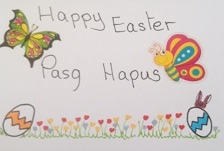I think this sums exactly why we started this whole new way of supporting children whose first language is not that of the classroom, or whose patients do not speak the same as the nurses and doctors, or whose new arrivals do not speak the same language as the officials, or whose customers and potential business partners do not speak the same language.
http://www.dailytoreador.com/opinion/article_73e2bc52-9c10-11e2-acc0-001a4bcf6878.html although this story revolves around a saying, the facts are really important if we are to change the way people think about how they communicate with others different from themselves.
The writer from America says My field of study is English as a second language education (ESL). (Ye be warned: educators speak in acronyms.) Notice the terminology here: Second language, not foreign language. No language should be referred to as “foreign,” a loaded and marginally xenophobic word at its best….
….I am simply communicating some important information about ESL and bilingual education. I would like to discuss some individual’s objections and misconceptions regarding ESL and bilingual education.
“The students don’t want to learn English.” I have commonly heard this complaint from teachers. “The ELLs (English Language Learners) don’t even try. They just sit there.” Researchers agree by the time a child is six years old, they know an average of 10,000 words in their native tongue.
A child who grew up in America knows 10,000 words in English, while a child who grew up in Ecuador knows 10,000 words in Spanish. The family of the Ecuadorian child moves to America. When both of these children start school the child from Ecuador is at a disadvantage.
The American child already has a vast lexicon of English at his disposal to aid in his comprehension of grade level material, while the Ecuadorian child at best may have some conversational phrases in English memorized.
This does not mean that the Ecuadorian child is not intelligent. The child simply does not know the language he is expected to use to communicate.
This child from Ecuador has to make up for its lack of a base knowledge in English all while being expected to perform at an appropriate level for grade-specific content. This obviously is very overwhelming for the student.
There is a phase in language acquisition called the silent period. The silent period can last anywhere from six weeks to a year depending on the student. A student in the silent period is not yet confident enough in his language skills to speak. By just sitting there, the child is soaking in the language doing his best to comprehend an entirely new way of communication.
ESL and bilingual programs teach cognitive academic language proficiency skills, or CALPS for short. This is the language necessary to be successful in an educational setting, not just ordering food or knowing some conversational phrases.
Another thing I hear frequently is, “Fine! They may need ESL and bilingual education. A year should be long enough.” Do you honestly expect someone who has grown up speaking another language to have the ability to be on par with their fluent English-speaking peers after only nine months of instruction? .
Something many do not realize about language is there are not merely different ways of saying the same thing; there are completely different systems of communication. Some grammatical or phonetic rules will translate across language barriers, but most will not.
Languages do not translate perfectly. Meaning will translate but not all exact words and phrases.
There are phrases and words in ancient Biblical Hebrew that do not necessarily translate comprehensibly today. Similarly, the differences between the words geek, nerd and dweeb in English are lost to many non-native English speakers. I have a Spanish speaking friend who occasionally has difficulty explaining what a Spanish phrase means to me. She says, “Well, it doesn’t really exist in English.”
This confusion can be likened to a PC person trying to use a Mac or a Trekie getting lost at a Doctor Who convention. They are similar but not exact. So to argue that it’s not that hard to learn another language is a complete failure to appreciate the complexity of communication.
The ultimate goal of ESL and bilingual education is its transition to a mainstream classroom with no ESL or native language support, not a cultural revolution where an entire generation of children refuse to speak English. Also, what does it mean to be American? To live in the suburbs with your spouse, a four-door sedan and two kids while eating apple pie and speaking English?
Babies don’t pop out of the womb talking. Similarly, a child who has grown up speaking Mandarin or Hindi will not immediately learn English simply by stepping foot on American soil. Have some compassion for these children. They are trying.
Being proficient in English is very important and beneficial in order to function well in American society. These programs are designed for nothing else but assisting these children to learn English. The goal is not replacement of their native language, but an additional acquisition of English. Please care about ESL and bilingual education. Our nation’s future might depend on it.
